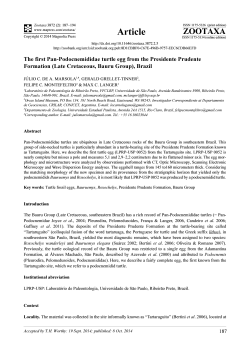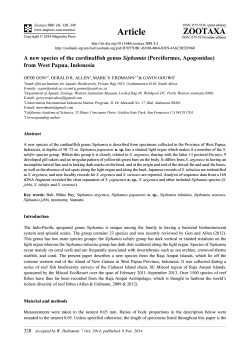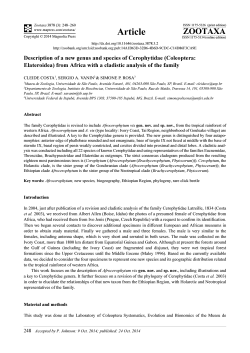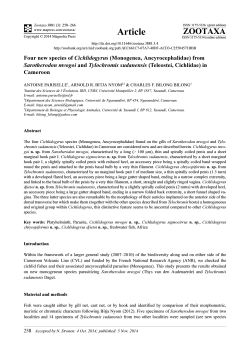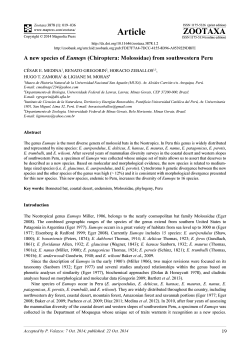
Preview - Magnolia Press
Zootaxa 3914 (4): 421–440 www.mapress.com /zootaxa / Copyright © 2015 Magnolia Press Article ISSN 1175-5326 (print edition) ZOOTAXA ISSN 1175-5334 (online edition) http://dx.doi.org/10.11646/zootaxa.3914.4.3 http://zoobank.org/urn:lsid:zoobank.org:pub:155185CB-A231-47E6-ACC9-39E11FCDDFA5 New basal hadrosauroid (Dinosauria: Ornithopoda) from the Lower Cretaceous Kitadani Formation, Fukui, central Japan MASATERU SHIBATA1,2 & YOICHI AZUMA1,2 1 Dinosaur Research Institute, Fukui Prefectural University, 4-1-1 Kenjojima, Matsuoka, Eiheiji-Cho, Fukui, 910-1195 Japan. E-mail: sdino@fpu.ac.jp, y-azuma@fpu.ac.jp 2 Fukui Prefectural Dinosaur Museum, 51-11, Terao, Muroko, Katsuyama-Shi, Fukui 911-8601, Japan Abstract A new basal hadrosauroid, Koshisaurus katsuyama, from the Lower Cretaceous Kitadani Formation in Fukui, central Japan, is reported. The new taxon is distinguished by an autapomorphy and a unique combination of maxillary, vertebral, pubic and femoral characters. A phylogenetic analysis indicates that Koshisaurus is positioned as a basal member of Hadrosauroidea and is more derived than the contemporaneous Fukuisaurus, which is a non-hadrosauroid hadrosauriform. The presence of the antorbital fossa on the maxilla and at least three subsidiary ridges on the labial side of maxillary tooth crown implies that Koshisaurus was among the most basal hadrosauroids. This discovery indicates a higher diversity of hadrosauroids along the eastern margin of the Asian continent in the Early Cretaceous. Key words: Early Cretaceous, Hadrosauroidea, Kitadani Formation, Tetori group, Japan Introduction Recent discoveries and descriptions of styracosternan iguanodonts indicate the great diversity of this group throughout the Early Cretaceous (You & Li 2009; McDonald et al. 2010a, b; Wu et al. 2010; You et al. 2011; McDonald et al. 2012; Wu & Godefroit 2012). In Asia, the fossil record of this group is extensive. However, discoveries in Asia are largely restricted to dinosaur-rich formations in China and Mongolia. Until recently, Fukuisaurus tetoriensis from the Lower Cretaceous (Barremian–lower Aptian) Kitadani Formation of Japan was the only named Asian styracosternan recognized from outside of this region (Kobayashi & Azuma 2003). The recent reports of two species of styracosternans in Thailand extended their diversity and distribution into Southeast Asia in the late Early Cretaceous (Buffetaut & Suteethorn 2011; Shibata et al. 2011). In Japan, styracosernan iguanodont discoveries in addition to Fukuisaurus include a maxillary tooth from the Tatsukawa Formation (Hauterivian) in Tokushima, several well-preserved teeth from the Kuwajima Formation (Barremian) in Ishikawa (Morozumi et al. 1995; Manabe & Barrett 2000), and shed teeth from the “Lower Formation” (lower Albian) of the Sasayama Group in Hyogo (Saegusa & Ikeda 2014). The Kitadani Formation, the uppermost unit of the Tetori Group, is the most productive dinosaur-bearing unit in Japan, having yielded Fukuiraptor kitadaniensis, Fukuisaurus tetoriensis and Fukuititan nipponensis (Azuma & Currie 2000; Kobayashi & Azuma 2003; Azuma & Shibata 2010). Additionally, ornithopod dentaries, which do not pertain to Fukuisaurus, have also been reported (Shibata & Azuma 2011). All of these dinosaurian specimens were found in one locality, the Kitadani Quarry in Katsuyama City (Fig. 1). At least four bonebeds are recognized at this locality (Fig. 2A); the definition of “bonebed” in this study follows Behrensmeyer (2007). The lowermost one, the Bonebed I (BB I), has yielded Fukuiraptor, Fukuisaurus, other dinosaur bones and teeth, and other vertebrates including crocodilians, turtles and fishes (Shibata & Goto 2008). Most of the BB I vertebrate assemblage consists of disarticulated or associated skeletons of dinosaurs and other vertebrates. Other horizons (BB II and III), which are approximately 10 m above BB I, yielded Fukuititan elements and a well-preserved small theropod skeleton (Shibata & Goto 2008), respectively. The iguanodontian bones described in this paper came from the fourth bone Accepted by S. Brusatte: 16 Dec. 2014; published: 29 Jan. 2015 421 In all consensus trees the two Fukui taxa are not particularly closely related. In the Adams consensus tree, for example, Koshisaurus is positioned at the base of Hadrosauroidea. In contrast, the other Fukui iguanodontian, Fukuisaurus, falls out as a basal hadrosauriform and closely related to Proa, Iguanodon and Ouranosaurus. Consequently, our analysis corroborates that Koshisaurus and Fukuisaurus are phylogenetically distinct; Koshisaurus is more derived than Fukuisaurus. Coexistence of at least two taxa of styracosternans occurred repeatedly during the Early Cretaceous. Examples include Barilium and Hypselospinus in the Wadhurst Clay Formation of England, Cedrorestes, Iguanocolossus and Hippodraco in the Cedar Mountain Formation of Utah, Iguanodon and Mantellisaurus in the Wessex Formation of England and Sainte-Barbe Clays Formation of Belgium, Bolong and Jinzhousaurus in the Yixian Formation of China, and Lurdusaurus and Ouranosaurus in the El Rhaz Formation of Niger (Taquet 1976; Norman 1980, 1986; Taquet & Russell 1999; Wang & Xu 2001;You and Ji et al. 2003; McDonald et al. 2010b; Wu & Godefroit 2012). Koshisaurus was one of the most primitive forms of Hadrosauroidea because it possesses an antorbital fossa and three subsidiary ridges on the maxillary teeth, similar to Equijubus (You et al. 2003). The subsidiary ridges of the maxillary teeth are also present in Xuwulong, Jinzhousaurus and Altirhinus among basal hadrosauroids, but these taxa lack the antorbital fossa on the maxilla (Norman 1998; You et al. 2003; Barrett et al. 2009). Conclusions A new hadrosauroid, Koshisaurus katsuyama from the Early Cretaceous Kitadani Formation, is a distinct new genus and species and distinguishable from the contemporaneous hadrosauriform Fukuisaurus tetoriensis. Due to its possession of an antorbital fossa and at least three subsidiary ridges on the crown of the maxillary teeth, Koshisarus is found to be one of the most primitive hadrosauroids in our phylogenetic analysis. The occurrence of numerous basal hadrosauroids in Asia suggests a diversification of this group in Asia during the Early Cretaceous period. Acknowledgments We are very thankful to all the people who contributed to the 3rd Dinosaur Excavation Project of Fukui Prefecture 2007–2010 and to the preparators at FPDM for their patient and skillful work. We are grateful to Drs. David Varricchio (Montana State University, Bozeman), Joshua Bonde (University of Nevada, Las Vegas), Kyo Tanoue (Fukuoka University, Japan), and Mr. Wenjie Zheng (Zhejiang Museum of Natural History, China) for their advice and editing this manuscript. One of authors (MS) extends special appreciation to Dr. Jack Horner (Museum of the Rockies, Montana State University, Bozeman), who encouraged the sampling of this material for histology, and to the Paleohistology Lab manager of MOR, Ellen-Therese Lamm for teaching the techniques for histological sectioning. Finally, we greatly appreciate useful comments and suggestions by the editor and reviewers to improve this manuscript. The Fukui Prefectural Government supported this research program. References Azuma, Y. & Currie, P.J. (2000) A new carnosaur (Dinosauria: Theropoda) from the Lower Cretaceous of Japan. Canadian Journal of Earth Sciences, 37, 1735–1753. http://dx.doi.org/10.1139/e00-064 Azuma, Y. & Shibata, M. (2010) Fukuititan nipponensis, a new titanosauriform sauropod from the Early Cretaceous Tetori Group of Fukui Prefecture, Japan. Acta Geologica Sinica-English Edition, 84, 454–462. Barrett, P.M., Butler, R.J., Wang, X. & Xu, X. (2009) Cranial anatomy of the iguanodontoid ornithopod Jinzhousaurus yangi from the Lower Cretaceous Yixian Formation of China. Acta Palaeontologica Polonica, 54, 35–48. http://dx.doi.org/10.4202/app.2009.0105 Behrensmeyer, A.K. (2007) Bonebeds through time. In: Rogers, R., Eberth, D. & Fiorillo, A. (Eds.), Bonebeds: Genesis, Analysis, and Paleobiological Significance. The University of Chicago Press, Chicago and London, pp. 65–102. http://dx.doi.org/10.7208/chicago/9780226723730.003.0002 Buffetaut, E. & Suteethorn, V. (2011) A new iguanodontian dinosaur from the Khok Kruat Formation (Early Cretaceous, NEW HADROSAUROID FROM JAPAN Zootaxa 3914 (4) © 2015 Magnolia Press · 437 Aptian) of northeastern Thailand. Annales de Paléontologie, 97, 51–62. http://dx.doi.org/10.1016/j.annpal.2011.08.001 Carpenter, K. & Wilson, Y. (2008) A new species of Camptosaurus (Ornithopoda: Dinosauria) from the Morrison Formation (Upper Jurassic) of Dinosaur National Monument, Utah, and a biomechanical analysis of its forelimb. Annals of Carnegie Museum, 76, 227–263. http://dx.doi.org/10.2992/0097-4463(2008)76[227:ANSOCO]2.0.CO;2 Canudo, J.I., Barco, J.L., Pereda-Suberbiola, X., Ruiz-Omeñaca, J.I., Salgado, L., Fernández-Baldor, F.T. & Gasulla, J.M. (2009) What Iberian dinosaurs reveal about the bridge said to exist between Gondwana and Laurasia in the Early Cretaceous. Bulletin de la Société géologique de France, 180 (1), 5–11. http://dx.doi.org/10.2113/gssgfbull.180.1.5 Cope, E.D. (1870) Synopsis of the extinct Batrachia and Reptilia of North America, 14, 1–252. Dollo, L. (1888) Iguanodontidae et Camptonotidae. Comptes Rendus de Academie des Sciences, Paris, 106, 775–777. Francillon-Vieillot, H., Buffrénil, V. De, Castanet, J., Géraudie, J., Meunier, F., Sire, J., Zylberberg, L. & Ricqlès, A. de (1990) Microstructure and mineralization of vertebrate skeletal tissues. In: Carter, J.G. (Ed.), Skeletal biomineralization: patterns, processes and evolutionary trends. an Nostrand Reinhold, New York, pp. 471–530. Gilmore, C.W. (1909) Osteology of the Jurassic reptile Camptosaurus, with a revision of the species of the genus, and descriptions of two new species. Proceedings of the United States National Museum, 36, 197–332. http://dx.doi.org/10.5479/si.00963801.36-1666.197 Gilpin, D., DiCroce, T. & Carpenter, K. (2007) A possible new basal hadrosaur from the Lower Cretaceous Cedar Mountain Formation of Eastern Utah. In: Carpenter, K. (Ed.), Horns and Beaks: Ceratopsian and Ornithopod Dinosaurs. Bloomington and Indianapolis, Indiana University Press, pp. 79–89. Godefroit, P., Li, H. & Shang, C. (2005) A new primitive hadrosauroid dinosaur from the Early Cretaceous of Inner Mongolia (PR China). Comptes Rendus Palevol, 4, 697–705. http://dx.doi.org/10.1016/j.crpv.2005.07.004 Goloboff, P.A., Farris, J.S. & Nixon, K.C. (2008) TNT, a free program for phylogenetic analysis. Cladistics, 24, 774–786. http://dx.doi.org/10.1111/j.1096-0031.2008.00217.x Hai, X., Wang, D., Han, F., Sullivan, C., Ma, Q., He, Y., Hone, D.W.E., Yan, R., Du, F. & Xu, X. (2014) A New Basal Hadrosauroid Dinosaur (Dinosauria: Ornithopoda) with Transitional Features from the Late Cretaceous of Henan Province, China. PLoS ONE, 9 (6), e98821. http://dx.doi.org/10.1371/journal.pone.0098821 Horner, J.R. & Currie, P.J. (1994) Embryonic and neonatal morphology and ontogeny of a new species of Hypacrosaurus (Ornithischia, Lambeosauridae) from Montana and Alberta. In: Carpenter, K. & Horner, J.H. (Eds.), Dinosaur Eggs and Babies. Cambridge University Press, Cambridge, pp. 313–336. Horner, J.R., Ricqlès, A. de, Padian, K. & Scheetz, R.D. (2009) Comparative long bone histology and growth of the “hypsilophodontid” dinosaurs Orodromeus makelai, Dryosaurus altus, and Tenontosaurus tillettii (Ornithischia: Euornithopoda). Journal of Vertebrate Paleontology, 29, 734–747. http://dx.doi.org/10.1671/039.029.0312 Isaji, S. (1993) Nippononaia ryosekiana (Bivalvia, Mollusca) from the Tetori Group in Central Japan. Bulletin of the National Science Museum, Series C, 19, 65–71. Kobayashi, Y. & Azuma, Y. (2003) A new iguanodontian (Dinosauria: Ornithopoda) from the Lower Cretaceous Kitadani Formation of Fukui Prefecture, Japan. Journal of Vertebrate Paleontology, 23, 39–45. http://dx.doi.org/10.1671/0272-4634(2003)23[166:ANIDOF]2.0.CO;2 Kubota, K. (2005) Charophyte gyrogonites from the Lower Cretaceous Kitadani Formation of the Tetori Group in the Takinamigawa area, Katsuyama City, Fukui Prefecture, central Japan. Paleontological Research, 9, 203–213. http://dx.doi.org/10.2517/prpsj.9.203 Manabe, M. & Barrett, P. (2000) Dinosaurs. In: Matsuoka, H. (Ed.), Fossils of the Kuwajima "Kaseki-kabe" (Fossil-bluff). Scientific report on a Neocomian (Early Cretaceous) fossil assemblage from the Kuwajima Formation, Tetori Group, Shiramine, Ishikawa, Japan. Shiramine Village Board of Education, Ishikawa Prefecture, Japan, pp. 93–98. Marsh, O. (1881) Classification of the Dinosauria. American Journal of Science series, 3, 81–86. McDonald, A.T. (2012) Phylogeny of Basal Iguanodonts (Dinosauria: Ornithischia): An Update. PLoS ONE, 7 (5), e36745. http://dx.doi.org/10.1371/journal.pone.0036745 McDonald, A.T., Barrett, P.M. & Chapman, S.D. (2010a) A new basal iguanodont (Dinosauria: Ornithischia) from the Wealden (Lower Cretaceous) of England. Zootaxa, 2569, 1–43. McDonald, A.T., Kirkland, J.I., DeBlieux, D.D., Madsen, S.K., Cavin, J., Milner, A.R. C. & Panzarin, L. (2010b) New Basal Iguanodonts from the Cedar Mountain Formation of Utah and the Evolution of Thumb-Spiked Dinosaurs. PLoS ONE, 5 (11), 1–35. http://dx.doi.org/10.1371/journal.pone.0014075 McDonald, A.T., Espilez, E., Mampel, L., Kirkland, J.I. & Alcalá, L. (2012) An unusual new basal iguanodont (Dinosauria: Ornithopoda) from the Lower Cretaceous of Teruel, Spain. Zootaxa, 3595, 61–76. Morozumi, Y., Kamei, T., Tashiro, M., Kikuchi, N., Ishida, K., Azuma, Y., Hashimoto, H. & Nakao, K. (1995) A dinosaur tooth from the Lower Cretaceous Tatsukawa Formation in Tokushima Prefecture, Japan. Bulletin of the Tokushima Prefectural 438 · Zootaxa 3914 (4) © 2015 Magnolia Press SHIBATA & AZUMA Museum, 5, 1–9. Norman, D.B. (1980) On the ornithischian dinosaur Iguanodon bernissartensis of Bernissart (Belgium). Mémoires de l’Institut Royal des Sciences Naturelles de Belgique, 178, 1–103. Norman, D.B. (1986) On the anatomy of Iguanodon atherfieldensis (Ornithischia: Ornithopoda). Bulletin de l’Institut Royal des Sciences Naturelles de Belgique, Sciences de la Terre, 56, 281–372. Norman, D.B. (1998) On Asian ornithopods (Dinosauria: Ornithischia). 3. A new species of iguanodontid dinosaur. Zoological Journal of the Linnean Society, 122, 291–348. http://dx.doi.org/10.1111/j.1096-3642.1998.tb02533.x Norman, D.B. (2002) On Asian ornithopods (Dinosauria: Ornithischia). 4. Probactrosaurus Rozhdestvensky, 1966. Zoological Journal of the Linnean Society, 136, 113–144. http://dx.doi.org/10.1046/j.1096-3642.2002.00027.x Norman, D.B. (2004) Basal Iguanodontia; In: Weishampel, D.B., Dodson, P.B. & Osmolska, H. (Eds.), The Dinosauria (Second Edition). University of California Press, Berkley, pp. 413–437. Norman, D.B. (2013) On the taxonomy and diversity of Wealden iguanodontian dinosaurs (Ornithischia: Ornithopoda). Revue de Paléobiologie, Genève, 32 (2), 385–404. Norman, D.B. & Weishampel, D.B. (1990) Iguanodontidae and related ornithopods: In: Weishampel, D.B., Dodson, P.B. & Osmolska, H. (Eds.), The Dinosauria. University of California Press, Berkeley, pp. 510–533. Owen, R. (1842) Report on British fossil reptiles, part II. Report of the Eleventh Meeting of the British Association for the Advancement of Science, Plymouth, London, pp. 66–204. Paul, G.S. (2008) A revised taxonomy of the iguanodont dinosaur genera and species. Cretaceous Research, 29, 192–216. http://dx.doi.org/10.1016/j.cretres.2007.04.009 Prieto-Márquez, A. (2011) Cranial and appendicular ontogeny of Bactrosaurus johnsoni, a hadrosauroid dinosaur from the Late Cretaceous of northern China. Palaeontology, 54, 773–792. http://dx.doi.org/10.1111/j.1475-4983.2011.01053.x Saegusa, H. & Ikeda, T. (2014) A new titanosauriform sauropod (Dinosauria: Saurischia) from the Lower Cretaceous of Hyogo, Japan. Zootaxa, 3848 (1), 1–66. http://dx.doi.org/10.11646/zootaxa.3848.1.1 Seeley, H.G. (1887) On the classification of the fossil animals commonly named Dinosauria. Proceedings of the Royal Society of London, 43, 165–171. http://dx.doi.org/10.1098/rspl.1887.0117 Sereno, P.C. (1986) Phylogeny of the bird-hipped dinosaurs (Order Ornithischia). National Geographic Research, 2, 234–256. Sereno, P.C. (1997) The origin and evolution of dinosaurs. Annual Review of Earth and Planetary Sciences, 25, 435–256. http://dx.doi.org/10.1146/annurev.earth.25.1.435 Sereno, P.C. (1998) A rationale for phylogenetic definitions, with application to the higher-level taxonomy of Dinosauria. Neues Jahrbuch für Geologie und Paläontologie, Abhandlungen, 210, 41–83. Sereno, P.C. (2005) Stem Archosauria version 1.0. TaxonSearch. Available from: http://www.taxonsearch.org/Archive/stemarchosauria-1.0.php (accessed 25 October 2013) Shibata, M. & Goto, M. (2008) Report of the 3rd Dinosaur Excavation Project in Katsuyama, Fukui, 2007. Memoir of the Fukui Prefectural Dinosaur Museum, 7, 109–116. Shibata, M. & Azuma, Y. (2011) Iguanodontian dentaries from the Lower Cretaceous Kitadani Formation, Fukui, Central Japan. International Hadrosaur Symposium, Abstract Volume, Royal Tyrell Museum of Palaeontology, Drumheller, pp. 1–131. Shibata, M., Jintasakul, P. & Azuma, Y. (2011) A new iguanodontian dinosaur from the Lower Cretaceous Khok Kruat Formation, Nakhon Ratchasima in northeastern Thailand. Acta Geologica Sinica, English Edition, 85, 969–976. http://dx.doi.org/10.1111/j.1755-6724.2011.00530.x Swofford, D.L. (2005) PAUP* Phylogenetic Analysis Using Parsimony (*and Other Methods). Version 4.0 beta 10. Sinauer Associates, Sunderland, MA, USA. Sues, H. & Norman. D.B. (1990) Hypsilophodontidae, Tenontosaurus, Dryosauridae. The Dinosauria, pp. 498–509. Taquet, P. (1976) Ostéologie d’Ouranosaurus nigeriensis, Iguanodontide du Crétacé Inférieur du Niger. Géologie et Paléontologie du gisement de Gadoufaoua (Aptien du Niger), Chapitre III, pp. 57–168. Taquet, P. & Russell, D.A. (1999) Un iguanodontidé massif de Gadoufaoua, Crétacé inférieur du Niger. Annales de paleontologie, 85 (1), 85–96. http://dx.doi.org/10.1016/S0753-3969(99)80009-3 Wang, X. & Xu, X. (2001) A new iguanodontid (Jinzhousaurus yangi gen. et. sp. nov.) from the Yixian Formation of Western Liaoning, China. Chinese Science Bulletin, 46, 1669–1672. http://dx.doi.org/10.1007/BF02900633 Weishampel, D.B., Csiki, Z., Benton, M.J., Grigorescu, D. & Codrea, V. (2010) Palaeobiogeographic relationships of the Haţeg biota—Between isolation and innovation. Palaeogeography, Palaeoclimatology, Palaeoecology, 293 (3), 419–437. http://dx.doi.org/10.1016/j.palaeo.2010.03.024 Wu, W. & Godefroit, P. (2012) Anatomy and relationships of Bolong yixianensis, an Early Cretaceous iguanodontoid Dinosaur from Western Liaoning, China. In: Godefroit, P. (Ed.), Bernissart Dinosaurs and Early Cretaceous Terrestrial Ecosystems, NEW HADROSAUROID FROM JAPAN Zootaxa 3914 (4) © 2015 Magnolia Press · 439 Indiana University Press, Bloomington, pp. 293–333. Wu, W., Godefroit, P. & Hu, D. (2010) Bolong yixianensis gen. et sp. nov.: A new iguanodontoid dinosaur from the Yixian Formation of Western Liaoning, China. Geology and Resources, 19, 127–133. Xing, H., Wang, D., Han, F., Sullivan, C. & Ma, Q. (2014) A new basal hadrosauroid dinosaur (Dinosauria: Ornithopoda) with transitional features from the Late Cretaceous of Henan Province, China. PLoS ONE, 9 (6), e98821. http://dx.doi.org/10.1371/journal.pone.0098821 You, H. & Li, D. (2009) A new basal hadrosauriform dinosaur (Ornithischia: Iguanodontia) from the Early Cretaceous of northwestern China. Canadian Journal of Earth Sciences, 46, 949–957. http://dx.doi.org/10.1139/E09-067 You, H. & Luo, Z. (2008) Dinosaurs from the Lower Cretaceous Gongpoquan Basin in Jiuquan Area, Gansu Province, China. Acta Geologica Sinica, 82, 139–144. You, H., Ji, Q. & Li, D. (2005) Lanzhousaurus magnidens gen. et sp. nov. from Gansu Province, China: the largest-toothed herbivorous dinosaur in the world. Geological Bulletin of China, 24 (9), 1–27. You, H., Li, D. & Liu, W. (2011) A new hadrosauriform dinosaur from the Early Cretaceous of Gansu Province, China. Acta Geologica Sinica, English Edition, 85, 51–57. http://dx.doi.org/10.1111/j.1755-6724.2011.00377.x You, H., Luo, Z., Shubin, N.H., Witmer, L.M., Tang, Z. & Tang, F. (2003) The earliest-known duck-billed dinosaur from deposits of late Early Cretaceous age in northwest China and hadrosaur evolution. Cretaceous Research, 24, 347–355. http://dx.doi.org/10.1016/S0195-6671(03)00048-X Zheng, W., Jin, X., Shibata, M. & Azuma, Y. (2014) An early juvenile specimen of Bolong yixianensis (Ornithopoda: Iguanodontia) from the Lower Cretaceous of Ningcheng County, Nei Mongol, China. Historical Biology, 26 (2), 236–251. http://dx.doi.org/10.1080/08912963.2013.809347 440 · Zootaxa 3914 (4) © 2015 Magnolia Press SHIBATA & AZUMA
© Copyright 2025

